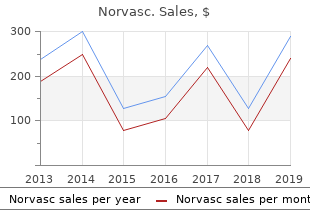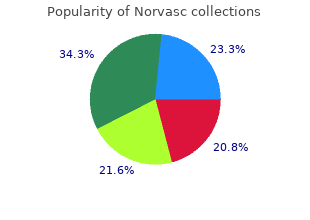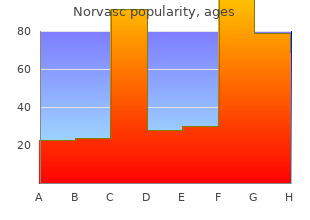Norvasc
"Buy 10 mg norvasc mastercard, blood pressure terms".
By: V. Musan, M.A., M.D.
Assistant Professor, Medical University of South Carolina College of Medicine
American College of Medical Toxicology position statement on post-chelator challenge urinary metal testing prehypertension while pregnant purchase norvasc 2.5mg otc. Mercury exposure: evaluation and intervention the inappropriate use of chelating agents in the diagnosis and treatment of putative mercury poisoning blood pressure quiz generic 10 mg norvasc with amex. A call to blood pressure chart daily purchase norvasc 10mg without a prescription arms for medical toxicologists: the dose, not the detection, makes the poison. Relative efcacy of phenytoin and phenobarbital for the prevention of theophylline-induced seizures in mice. Infuence of certain anticonvulsants on the concentration of gamma-aminobutyric acid in the cerebral hemispheres of mice. Clinical efects of colonic cleansing for general health promotion: a systematic review. Do people with idiopathic environmental intolerance attributed to electromagnetic felds display physiological efects when exposed to electromagnetic felds Idiopathic environmental intolerance: Part 2: causation analysis applying Bradford Hill�s criteria to the psychogenic theory. Idiopathic environmental intolerance: Part 1: a causation analysis applying Bradford Hill�s criteria to the toxicogenic theory. The pitfalls of hair analysis for toxicants in clinical practice: three case reports. Fasciotomy worsens the amount of myonecrosis in a porcine model of crotaline envenomation. Compartment syndrome after South American rattlesnake (Crotalus durissus terrifcus) envenomation. Elevated compartment pressures from copperhead envenomation successfully treated with antivenin. We achieve this by collaborating with is an association of physicians with recognized expertise physicians and physician leaders, medical trainees, in the diagnosis, management and prevention of human health care delivery systems, payers, policymakers, poisoning and other adverse health effects due to consumer organizations and patients to foster a shared medications, occupational and environmental toxins understanding of professionalism and how they can and biological agents. The American College of Obstetricians and Gynecologists Ten Things Physicians and Patients Should Question Don�t schedule elective, non-medically indicated inductions of labor or Cesarean deliveries before 39 weeks 0 days gestational age. There are clear medical indications for delivery prior to 39 weeks 0 days based on maternal and/or fetal conditions. A mature fetal lung test, in the absence of appropriate clinical criteria, is not an indication for delivery. Don�t schedule elective, non-medically indicated inductions of labor between 39 weeks 0 days and 41 weeks 0 days unless the cervix is deemed favorable. Health care practitioners should discuss the risks and benefts with their patients before considering inductions of labor without medical indications. Don�t perform routine annual cervical cytology screening (Pap tests) in women 30�65 years of age. However, a well-woman visit should occur annually for patients with their health care practitioner to discuss concerns and problems, and have appropriate screening with consideration of a pelvic examination. Because of the low prevalence of ovarian cancer and the invasive nature of the interventions required after a positive screening test, the potential harms of screening outweigh the potential benefts. Recommendation #6 revised August 24, 2016 the American College of Obstetricians and Gynecologists Ten Things Physicians and Patients Should Question Avoid using robotic assisted laparoscopic surgery for benign gynecologic disease when it is feasible to use a conventional laparoscopic or vaginal approach. However, evidence shows that robotic-assisted laparoscopic surgery has similar or longer operating times and higher associated costs. Don�t perform prenatal ultrasounds for non-medical purposes, for example, solely to create keepsake videos or photographs. Food and Drug Administration considers keepsake imaging as an unapproved use of a medical device. The American Institute of Ultrasound in Medicine also discourages the non-medical use of ultrasound for entertainment purposes. Keepsake ultrasounds are not medical tests and should not replace a clinically performed sonogram. Don�t routinely transfuse stable, asymptomatic hospitalized patients with a hemoglobin level greater than 7�8 grams. Arbitrary hemoglobin or hematocrit thresholds should not be used as the only criterion for transfusions of packed red blood cells.

Answers to blood pressure higher at night discount 2.5mg norvasc with mastercard these moral questions are subjective blood pressure on forearm purchase 2.5 mg norvasc fast delivery, and as such there are many shades of grey as answers cannot realistically be determined on a yes or no basis heart attack 42 year old generic 5 mg norvasc amex. However, they can provide a process for ethical deliberation for decision-making in this difficult area and will either affirm personal values or challenge them. Our health system and its health professionals have a general duty to provide treatment which benefits all patients; the bioethical principle of beneficience being one of the four cornerstones of modern health care. Benefit can be physiological or it can also be other factors important to the patient, such as quality of life. A therapeutic benefit occurs when a medical treatment or procedure confers some sort of symptomatic relief for the patient or improves the patient�s condition or prognosis in a real and meaningful way. Health professionals also have responsibilities toward society in addition to the responsibilities they have to individual patients. Health care professionals are employed by society to provide medical care that is safe, appropriate and affordable. The practical expression of beneficence therefore requires judiciousness and genuine concern for the wellbeing of the total society. This must necessarily include the wise use of scarce resources and some recognition of the financial and clinical limits to clinical medicine. The decision to prolong life by providing life-sustaining measures is usually, but not always, a benefit. When we consider benefit in health terms, concepts like progress, recovery, remission, symptom reduction and pain relief are raised in the context of the discussion. For example, the benefit may be that a patient is able to maintain status quo in their condition without further deterioration. In other cases, benefit may keep the patient alive, but fail to halt the progression of a serious illness. In making the treatment decisions, a patient with decision-making capacity will weigh relative 188 benefits and burdens among treatment options. End-of-life care: Guidelines for decision-making about withholding and withdrawing January 2018 105 life-sustaining measures from adult patients the burden of prolonging life in the most extreme cases where there is multiple morbidity and no reasonable prospect of recovery should weigh on the side of palliative care rather than finding cures through active treatment. Arguably, in these cases, there is little or no benefit in subjecting the patient to an endless regime of tests and therapies that are potentially futile and have no chance of restoring their health. Applying life-sustaining measures to prolong life in these circumstances may be causing more harm to the patient than benefit, particularly if pain is involved. This is where the health care team must carefully weigh up and consider all factors in a 189 patient�s quality of life. Patients differ in their perceptions of benefits and burdens and in how they balance them. For most, but not all, patients, consequences of treatment that are experienced as benefits include: the relief of pain and/or symptoms that cause suffering improved functionality the opportunity to live longer, if the quality of prolonged life is acceptable to the patient the opportunity to do things that have meaning or give pleasure to the patient the possibility of fulfilling specific goals. In decision-making about withholding and withdrawing life-sustaining measures, a similar test applies. It is a tenuous moral and ethical balancing act to determine what benefits a patient might receive against harm done to them. Open and honest communication at all points along the decision-making pathway with a patient�s family can assist in the decision-making process. When discussing the concept of how the patient benefits from certain forms of treatment, unilateral decisions about withholding or withdrawing a life-sustaining measure must never be made on behalf of a patient with capacity. Patients with capacity are in the best position to judge what represents an acceptable level of burden or risk for them, and their wishes must be respected even if this results in perceived harm to them. As previously discussed, this important principle underpins the concept of patient autonomy. In circumstances where a patient does not have capacity, they are not involved in assessing whether benefit is achieved. For example, if a patient is known to have the view that there is no intrinsic value in prolonging life at any cost, life-sustaining measures would, arguably, provide no benefit to that individual and would not be in their best interests.

Reduce intravenous fluids gradually when the rate of plasma leakage decreases towards the end of the critical phase arteria technologies cheap norvasc 10 mg otc. This is indicated by urine output and/or oral fluid intake improving blood pressure by age chart order norvasc 2.5mg fast delivery, or the haematocrit decreasing below the baseline value in a stable patient blood pressure chart age 35 purchase cheap norvasc on line. Parameters that should be monitored include vital signs and peripheral perfusion (14 hourly until the patient is out of the critical phase), urine output (46 hourly), haematocrit (before and after fluid replacement, then 612 hourly), blood glucose and other organ functions (such as renal profile, liver profile, coagulation profile, as indicated). If the patient has dengue with co-existing conditions but without warning signs, the action plan should be as follows: � Encourage oral fluids. Use the ideal body weight for calculation of fluid infusion for obese and overweight patients (Textboxes J and K). Patients may be able to take oral fluids after 26 a few hours of intravenous fluid therapy. Patients should be monitored by health-care providers for temperature pattern, volume of fluid intake and losses, urine output (volume and frequency), warning signs, haematocrit, white blood cell and platelet counts (Textbox K). Depending on the clinical picture and the facilities of the hospital or health centre, other laboratory tests (such as liver and renal functions tests) can also be carried out. All patients with severe dengue should be admitted to a hospital with access to blood transfusion facilities. Judicious intravenous fluid resuscitation is the essential and usually sole intervention required. The crystalloid solution should be isotonic and the volume just sufficient to maintain an effective circulation during the period of plasma leakage. Plasma losses should be replaced immediately and rapidly with isotonic crystalloid solution: in the case of hypotensive shock, colloid solution is preferred (Textbox L). Continue replacement of further plasma losses to maintain effective circulation for 2448 hours. For overweight or obese patients, the ideal body weight should be used for calculating fluid infusion rates (see Textboxes J and K). All shock patients should have their blood group taken and a cross-match carried out. Blood transfusion should be given only in cases with established severe bleeding, or suspected severe bleeding in combination with otherwise unexplained hypotension. Input is typically much greater than output, and the input/output ratio is of no help in judging fluid resuscitation needs during this period. The goals of fluid resuscitation include: � improving central and peripheral circulation � i. Start intravenous fluid resuscitation with isotonic crystalloid solutions at 510 ml/kg/hour over one hour in adults and 1020 ml/kg/hour over one hour in infants and children. Then reassess the patient�s condition (vital signs, capillary refill time, haematocrit, urine output). After this second bolus, if there is improvement continue with crystalloid solution and reduce the rate to 710 ml/kg/hour for 12 hours, then continue to reduce as above. If haematocrit decreases compared to the initial reference haematocrit (especially if the repeat haematocrit is below the baseline, for example < 3540% in adult females, < 4045% in adult males), and the patient still has unstable vital signs, this may indicate bleeding. Cross-match fresh whole blood or fresh packed red cells and transfuse if there is severe overt bleeding, If there is no bleeding, give a bolus of 1020 ml of colloid, repeat clinical assessment and determine the haematocrit level. A senior staff member should carry out a review to consider blood transfusion (see Section 2. After the initial dose, reduce the rate to 10 ml/kg/hour for 1 hour, then reduce to 7 ml/kg/hour. If the haematocrit decreases compared to the initial reference haematocrit (especially if the repeat haematocrit is below the baseline, for example, 28 < 3540%), and the patient still has unstable vital signs, this may indicate bleeding. If there is no bleeding, give a bolus of 1020 ml/kg of colloid over 1 hour, repeat clinical assessment and determine the haematocrit level. The action plan for treating patients with hypotensive shock is outlined below (also see Textbox D and Figure 7). For all patients (infants, children and adults), initiate intravenous fluid resuscitation with crystalloid or colloid solution at 20 ml/kg as a bolus given over 1530 minutes to bring the patient out of shock as quickly as possible. Colloids have been shown to restore the cardiac index and reduce the level of haematocrit faster than crystalloids in patients with intractable shock (4�6).
Cheap norvasc 2.5 mg. Blood Pressure : Types of Blood Pressure Medication.


